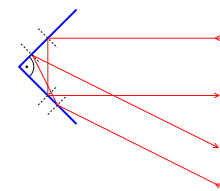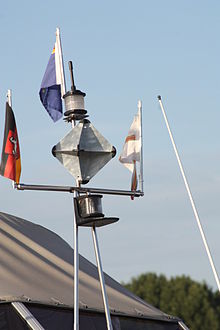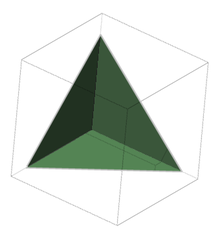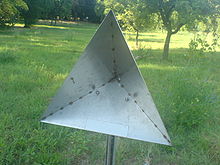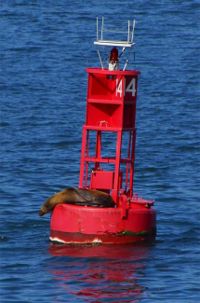- Corner reflector
-
A corner reflector is a retroreflector consisting of three mutually perpendicular, intersecting flat surfaces, which reflects waves back directly towards the source, but shifted (translated). Unlike a simple mirror, they work for a relatively wide-angle field of view. The three intersecting surfaces often have square shapes. This is also known as a corner cube.
Contents
Usage
Corner reflectors are placed on the vessel's masts at a height of at least 4.6 meters above sea level. Popular corner reflectors used on ships are (amongst others) the RORC radar reflectors,[1] Firdel Blippers and EchoMax radar reflectors.
Such devices are often used as radar targets or markers and are often employed on ships and, especially, lifeboats. These normally consist of three conducting metallic surfaces or screens perpendicular to one another.
In optics, corner reflectors typically consist of three mirrors or reflective prisms which return an incident light beam in the opposite direction. In surveying, such prisms are commonly used as targets for long-range electronic distance measurement using a total station.
Arrays of corner reflectors are used in automobile and bicycle tail lights. Microscopic corner reflector structures can be incorporated into reflective paint for increased visibility at night, although retroreflective spherical beads are more common for this purpose.
A directional antenna using two mutually intersecting conducting flat surfaces is also considered to be a type of corner reflector.
Corner reflectors can also occur accidentally. Tower blocks with balconies are often accidental corner reflectors for sound and return a distinctive echo to an observer making a sharp noise, such as a hand clap, nearby. Similarly, in radar interpretation, an object that has multiple reflections from smooth surfaces produces a radar return of greater magnitude than might be expected from the physical size of the object. This effect was put to use on the ADM-20 Quail, a small missile which had the same radar cross section as a B-52.
NASA has put several optical corner reflectors made of quartz, known as the Lunar Laser Ranging Experiment, on the Moon for use in laser interferometry to measure the Moon's orbit more precisely than was possible before.
See also
References
 This article incorporates public domain material from the General Services Administration document "Federal Standard 1037C" (in support of MIL-STD-188).
This article incorporates public domain material from the General Services Administration document "Federal Standard 1037C" (in support of MIL-STD-188). This article incorporates public domain material from the United States Department of Defense document "Dictionary of Military and Associated Terms".
This article incorporates public domain material from the United States Department of Defense document "Dictionary of Military and Associated Terms".
External links
- Example: http://www.landfallnavigation.com/sd152.html
- Corner Reflector Antennas: http://www.antenna-theory.com/antennas/reflectors/cornerReflector.php
- Corner Reflector for WiFi: http://www.freeantennas.com/projects/Ez-10/
Categories:- Mirrors
- Radar
Wikimedia Foundation. 2010.

